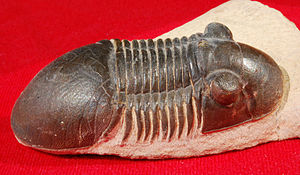Paralejurus
| Paralejurus | ||||||||||||
|---|---|---|---|---|---|---|---|---|---|---|---|---|

Paralejurus sp. from Alnif , Morocco (length: 7 cm) |
||||||||||||
| Temporal occurrence | ||||||||||||
| Pragium to Emsium | ||||||||||||
| 411.2 to 397.5 million years | ||||||||||||
| Locations | ||||||||||||
|
||||||||||||
| Systematics | ||||||||||||
|
||||||||||||
| Scientific name | ||||||||||||
| Paralejurus | ||||||||||||
| Hawle & Corda , 1847 | ||||||||||||
Paralejurus is a genus of trilobites from the Lower Devonian . Presumably this species dug holes in the ocean floor. This way of life wouldexplainthe clearly curved exoskeleton . This genus of trilobites has lost many of the body features typical of trilobites and has developed an almost smooth exoskeleton in the head and tail area. The development of less detailed exoskeletons occurs in some trilobite species, but has not been able to fully establish itself.
features
These animals, up to nine centimeters long, had an oval shape and a highly domed exoskeleton. The cephalon has a smooth, detailed surface and an almost inconspicuous occipital lobe behind the glabella in the transition to the thorax. The compound eyes have crescent-shaped lids. The thorax consists of ten narrow segments and a clearly arched and broad axial lobe ( rachis ). The pygidium is very broad and shaped like a thumbnail. The axial lobe ends on it rounded and raised. Twelve to fourteen fine furrows extend radially from this elevation. In contrast to the genus Scutellum with a pygidium with clear furrows, in Paralejurus the pygidium is very smooth and strongly overgrown.
Occurrence
The fossils were found in the strata of the Pragian and Emsian . A species in Kazakhstan ( P. balchushensis ) has been described as a Silurian- Devonian species, only the biostratigraphic evidence is missing . Twelve secured species have been found in the strata of the Pragium. In the early emsium and the late emsium, only six and five secured species were found.
Way of life
An endobenthic or semi- endobenthic way of life is assumed . The highly domed exoskeleton and the vanishing details on the cephalon and pygidium fit a burrowing genus. Especially the Bohemian species were found in limestone , which corresponds to the humus-rich, calcareous clay soil of the earlier sea, far from reefs, and supports the assumption of the burrowing way of life.
Evolutionary development
It was previously assumed that this genus could have developed from the genus Scutellum , Scabriscutellum or Decoroscutellum in the transition period from Pridolium to Lochkovium . However, important phylogenetic features contradict a development from the scutellum , such as the shape of the furrows on the pygidium and the glabella. However, many characteristics are very similar to the earlier species of the Illaenina , so that a relationship must be assumed.
The Paralejurus species have changed in the transition from the pragium to the emsium: The librigenae (the "free cheeks" below the compound eyes) end very bluntly, almost at right angles, in species of the pragium . In the Emsium species, on the other hand, thorns can be seen there, which run backwards parallel to the longitudinal axis of the body. The axial lobe ends bell-shaped in earlier species on the pragium. In older species, this point is very narrow and elongated vertically. (See schematic illustration.)
This genus has diversified into many species, especially in the Pragian. In the Emsium, the number of species then fell sharply, and Paralejurus finally died out at the transition to the Middle Devon . The sudden global extinction speaks for a change in the basis of life from the outside for the entire biota of that time .
species
Most of the species described so far lived in the pragium. Fewer species have been recorded in the later Devonian Age. There are still fragments of fossils of new undescribed species.

Species earlier than pragium
- Paralejurus balchushensis Maksimova, 1975 • Silurian to Lochkovian (unconfirmed) • Central Kazakhstan
Types of pragium
- Paralejurus bohemicus Šnajdr, 1960 • Pragium • Bohemia
- Paralejurus brongniarti brongniarti (Barrande, 1846) • Pragium • Bohemia
- Paralejurus brongniarti menanensis Šnajdr, 1960 • Pragium • Bohemia
- Paralejurus brongniarti mixal Šnajdr, 1986 • Pragium • Bohemia
- Paralejurus campanifer (Beyrich, 1845) • Pragium • Bohemia
- Paralejurus elayounensis Schraut, 2000 • Pragium • Southern Morocco
- Paralejurus spatuliformis Schraut and Feist, 2004 • Pragium • Southern Morocco
- Paralejurus verneuili , Oehlert and Davoust, 1879 • Pragium • France
- Paralejurus zippei , (Barrande, 1846) • Pragium • Bohemia
Species in transition from pragium to emsium
- Paralejurus brongniarti (Barrande, 1846) • Pragium to Lower Emsium • Bohemia
- Paralejurus hamlagdadicus Alberti, 1983 • Pragium • Morocco
- Paralejurus richteri Šnajdr, 1960 • Upper Prague to Emsium • Bohemia, Germany
Types of Unteremsium
- Paralejurus carlsi Schraut and Feist, 2004 • Lower Emmium • Spain
- Paralejurus depressus Feist, 1974 • Lower Emsium • France (Montagne Noire)
- Paralejurus rugosus Feist, 1974 • Lower Emsium • France (Montagne Noire)
- Paralejurus subcampanifer (Frech, 1887) • Lower Emsium • France (Montagne Noire), Austria
- Paralejurus teres , Ancigin, 1979 • Lower Emsium • Russia (Eastern Urals)
Types of Emsium
- Paralejurus galloisi Oehlert and Oehlert, 1890 • Emsium • France
- Paralejurus dormitzeri ligeriensis Fillet, 1972 • Emsium • France
Types of Oberemsium
- Paralejurus dormitzeri applanatux (Novák, 1890) • Oberemsium • Germany
- Paralejurus dormitzeri dormitzeri (Barrande, 1852) • Upper Emsium • Bohemia, Poland, France, Germany
- Paralejurus intumescens Roemer, 1855 • Oberemsium • Germany
- Paralejurus rehamnanus Alberti, 1970 • Oberemsium • Morocco, Germany
- Paralejurus tenuistriatus Schraut and Feist, 2004 • Upper Emsium • South Morocco
Individual evidence
- ↑ a b c d e f g h Gunnar Schraut, Devonian Styginid Trilobite Paralejurus, with new data from Spain and Marocco in: Journal of Paleontology, 78 (4): 709-722, July 2004




